 Specific contextual cues are added to media messages that persuade people to think one way or another about an issue and influence their actions. In this publication, you will learn the different ways that the mass media use persuasion and how persuasion encourages the audience to change their attitudes or behavior. This 3-page fact sheet was written by Laura Gorham, Ricky Telg, and Tracy Irani, and published by the UF Department of Agricultural Education and Communication, July 2013.
Specific contextual cues are added to media messages that persuade people to think one way or another about an issue and influence their actions. In this publication, you will learn the different ways that the mass media use persuasion and how persuasion encourages the audience to change their attitudes or behavior. This 3-page fact sheet was written by Laura Gorham, Ricky Telg, and Tracy Irani, and published by the UF Department of Agricultural Education and Communication, July 2013.
http://edis.ifas.ufl.edu/wc145
Category: Program Development
Persuasive Papers, Speeches, and Campaigns
 Persuasion can be used in written essays, speeches or as part of media campaigns that attempt to influence an audience to change their thinking or behavior. This publication will familiarize you with the tools necessary to develop a persuasive essay, speech, or media campaign. This 3-page fact sheet was written by Laura Gorham, Ricky Telg, and Tracy Irani, and published by the UF Department of Agricultural Education and Communication, July 2013.
Persuasion can be used in written essays, speeches or as part of media campaigns that attempt to influence an audience to change their thinking or behavior. This publication will familiarize you with the tools necessary to develop a persuasive essay, speech, or media campaign. This 3-page fact sheet was written by Laura Gorham, Ricky Telg, and Tracy Irani, and published by the UF Department of Agricultural Education and Communication, July 2013.
http://edis.ifas.ufl.edu/wc146
Planning Special Events
 Learning how to plan special events is an important skill that can benefit you and your organization. This publication is designed to help you understand what special events are and how to conduct them. After reading this publication, you will be able to explain how event sites are chosen, what criteria are used to plan events, and how to handle site permits, contracts, and budgets. You also will learn the five critical stages in planning a special event and how to evaluate an event. This 6-page fact sheet was written by Reba Ellen Hicks, Ricky Telg, and Tracy Irani, and published by the UF Department of Agricultural Education and Communication, July 2013.
Learning how to plan special events is an important skill that can benefit you and your organization. This publication is designed to help you understand what special events are and how to conduct them. After reading this publication, you will be able to explain how event sites are chosen, what criteria are used to plan events, and how to handle site permits, contracts, and budgets. You also will learn the five critical stages in planning a special event and how to evaluate an event. This 6-page fact sheet was written by Reba Ellen Hicks, Ricky Telg, and Tracy Irani, and published by the UF Department of Agricultural Education and Communication, July 2013.
http://edis.ifas.ufl.edu/wc147
Event Marketing and Public Relations
 Marketing your event so that people know about it and are motivated to attend is extremely important. The five P’s of marketing – product, promotion, price, place (location), and public relations – must be taken into consideration in order to have an event that is well attended. This 2-page fact sheet was written by Reba Ellen Hicks, Ricky Telg, and Tracy Irani, and published by the UF Department of Agricultural Education and Communication, July 2013.
Marketing your event so that people know about it and are motivated to attend is extremely important. The five P’s of marketing – product, promotion, price, place (location), and public relations – must be taken into consideration in order to have an event that is well attended. This 2-page fact sheet was written by Reba Ellen Hicks, Ricky Telg, and Tracy Irani, and published by the UF Department of Agricultural Education and Communication, July 2013.
http://edis.ifas.ufl.edu/wc148
The Savvy Survey #5: The Process for Developing Survey Questions
 A useful process for developing a high-quality questionnaire follows four steps. Brainstorm questions on a topic. Review the literature for concepts, questions, and indices. Collect ideas for questions and wording choices through focus groups or key informant interviews. And select questions linked to a program’s logic model. Each of these steps is discussed in this 3-page fact sheet written by Glenn D. Israel and Jessica L. Gouldthorpe, and published by the UF Department of Agricultural Education and Communication, August 2013.
A useful process for developing a high-quality questionnaire follows four steps. Brainstorm questions on a topic. Review the literature for concepts, questions, and indices. Collect ideas for questions and wording choices through focus groups or key informant interviews. And select questions linked to a program’s logic model. Each of these steps is discussed in this 3-page fact sheet written by Glenn D. Israel and Jessica L. Gouldthorpe, and published by the UF Department of Agricultural Education and Communication, August 2013.
http://edis.ifas.ufl.edu/pd065
Speaking with Policymakers About Current Issues
 The future of the agricultural and natural resource industry requires that educators, industry professionals, and policymakers work together when addressing contentious issues. However, discussing contentious issues with policymakers at the local, state, and national level is not always an easy task. Policymakers in general are busy people with many issues competing for their limited time. Once in the door, it is important to deliver strong messages in the right way for the policymaker to listen and use your information when making important decisions. This 2-page fact sheet discusses the differences between education and persuasion and when to use each, offers information on how to make presentations that will get their attention, and identifies things to avoid when visiting with a policymaker. Written by Alexa J. Lamm, and published by the UF Department of Agricultural Education and Communication, August 2013.
The future of the agricultural and natural resource industry requires that educators, industry professionals, and policymakers work together when addressing contentious issues. However, discussing contentious issues with policymakers at the local, state, and national level is not always an easy task. Policymakers in general are busy people with many issues competing for their limited time. Once in the door, it is important to deliver strong messages in the right way for the policymaker to listen and use your information when making important decisions. This 2-page fact sheet discusses the differences between education and persuasion and when to use each, offers information on how to make presentations that will get their attention, and identifies things to avoid when visiting with a policymaker. Written by Alexa J. Lamm, and published by the UF Department of Agricultural Education and Communication, August 2013.
http://edis.ifas.ufl.edu/wc152
The Savvy Survey #13: Online Surveys
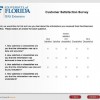 As part of the Savvy Survey Series, this publication provides Extension faculty with an overview of the process that uses email to invite participants to complete an on-line survey. This 10-page fact sheet provides guidance for constructing an online questionnaire, addressing visual design and formatting considerations, and implementing an online survey. Written by Glenn D. Israel and Jessica L. Gouldthorpe, and published by the UF Department of Agricultural Education and Communication, August 2013.
As part of the Savvy Survey Series, this publication provides Extension faculty with an overview of the process that uses email to invite participants to complete an on-line survey. This 10-page fact sheet provides guidance for constructing an online questionnaire, addressing visual design and formatting considerations, and implementing an online survey. Written by Glenn D. Israel and Jessica L. Gouldthorpe, and published by the UF Department of Agricultural Education and Communication, August 2013.
http://edis.ifas.ufl.edu/pd077
The Savvy Survey #1: Introduction
 This initial publication in the Savvy Survey Series provides Extension faculty who are interested in creating savvy surveys with a brief introduction to survey design and basic considerations to make when choosing to use a survey for program planning and evaluation. The publication also provides an introduction to and overview of the Savvy Survey Series in Appendix A. This 5-page fact sheet was written by Jessica L. Gouldthorpe and Glenn D. Israel, and published by the UF Department of Agricultural Education and Communication, August 2013.
This initial publication in the Savvy Survey Series provides Extension faculty who are interested in creating savvy surveys with a brief introduction to survey design and basic considerations to make when choosing to use a survey for program planning and evaluation. The publication also provides an introduction to and overview of the Savvy Survey Series in Appendix A. This 5-page fact sheet was written by Jessica L. Gouldthorpe and Glenn D. Israel, and published by the UF Department of Agricultural Education and Communication, August 2013.
http://edis.ifas.ufl.edu/pd061
Developing Strong Teamwork to Support Excellence in Extension Programming
 Sometimes differentiating a group from a team is difficult. Is the group of people that you work with truly a team? What benefits are there to being a member of a highly functioning team? In Patrick Lencioni’s iconic book on teamwork, The Five Dysfunctions of a Team , five elements are outlined as necessary for highly functioning teams. These are trust, ability to successfully engage in conflict, commitment to each other and the team, accountability, and focusing on collective results. This 2-page fact sheet was written by Hannah Carter, Amy Harder, and Kevan Lamm, and published by the UF Department of Agricultural Education and Communication, May 2013.
Sometimes differentiating a group from a team is difficult. Is the group of people that you work with truly a team? What benefits are there to being a member of a highly functioning team? In Patrick Lencioni’s iconic book on teamwork, The Five Dysfunctions of a Team , five elements are outlined as necessary for highly functioning teams. These are trust, ability to successfully engage in conflict, commitment to each other and the team, accountability, and focusing on collective results. This 2-page fact sheet was written by Hannah Carter, Amy Harder, and Kevan Lamm, and published by the UF Department of Agricultural Education and Communication, May 2013.
http://edis.ifas.ufl.edu/wc143
Engaging Distance Learners in Cooperative Extension
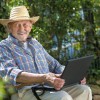 Distance education allows organizations to reach broader audiences, reduce costs per learner, and better serve communities. This 4-page fact sheet discusses how to incorporate the best practices for engaging learners in online distance education programs. Written by Austen Moore and Amy Harder, and published by the UF Department of Agricultural Education and Communication, May 2013.
Distance education allows organizations to reach broader audiences, reduce costs per learner, and better serve communities. This 4-page fact sheet discusses how to incorporate the best practices for engaging learners in online distance education programs. Written by Austen Moore and Amy Harder, and published by the UF Department of Agricultural Education and Communication, May 2013.
http://edis.ifas.ufl.edu/wc142
Reusable Learning Objects: Tools for Teaching in Nonformal Education (WC140)
 Reusable learning objects are short, self-contained, digital learning activities that can be valuable tools for sharing information. This 4-page fact sheet provides a brief synopsis of what reusable learning objects are and how to create an them for use in an educational setting. Written by Jessica L. Gouldthorpe, Amy Harder, T. Grady Roberts, and Nicole Stedman, and published by the UF Department of Agricultural Education and Communication, April 2013.
Reusable learning objects are short, self-contained, digital learning activities that can be valuable tools for sharing information. This 4-page fact sheet provides a brief synopsis of what reusable learning objects are and how to create an them for use in an educational setting. Written by Jessica L. Gouldthorpe, Amy Harder, T. Grady Roberts, and Nicole Stedman, and published by the UF Department of Agricultural Education and Communication, April 2013.
http://edis.ifas.ufl.edu/wc140
Developing Urban Community Garden Projects (WC139)
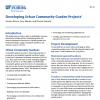 Community gardens are pieces of land where groups of people grow and maintain vegetable and flower plants. They exist in all types of areas, including neighborhoods, at schools, or on other public or private lands. Community gardens grow food for local consumption or sale and can also be used for teaching gardening and other skills This 7-page fact sheet provides a guide to individuals or groups interested in starting urban community gardens and includes information about how to identify garden sites, build partnerships, engage community members, and develop a project overview. Written by Austen Moore, Amy Harder, and Norma Samuel, and published by the UF Department of Agricultural Education and Communication, March 2013.
Community gardens are pieces of land where groups of people grow and maintain vegetable and flower plants. They exist in all types of areas, including neighborhoods, at schools, or on other public or private lands. Community gardens grow food for local consumption or sale and can also be used for teaching gardening and other skills This 7-page fact sheet provides a guide to individuals or groups interested in starting urban community gardens and includes information about how to identify garden sites, build partnerships, engage community members, and develop a project overview. Written by Austen Moore, Amy Harder, and Norma Samuel, and published by the UF Department of Agricultural Education and Communication, March 2013.
http://edis.ifas.ufl.edu/wc139
Being Smart About Gluten and Gluten-Free Issues, Part 1: What Are the Health Concerns Surrounding Gluten? (WC133/WC133)
 Are you an inquisitive consumer who asks what the big deal is about gluten free? Ask no more; this article is the first in a three–part series about gluten. This 7-page fact sheet identifies health conditions surrounding the ingestion of gluten. The resources used in this article are research and evidence based and/or peer reviewed to provide straightforward and simple information about a few gluten-related topics. Written by Abigail Dicks, Amy Harder, and Amy Simonne, and published by the UF Department of Agricultural Education and Communication, January 2013.
Are you an inquisitive consumer who asks what the big deal is about gluten free? Ask no more; this article is the first in a three–part series about gluten. This 7-page fact sheet identifies health conditions surrounding the ingestion of gluten. The resources used in this article are research and evidence based and/or peer reviewed to provide straightforward and simple information about a few gluten-related topics. Written by Abigail Dicks, Amy Harder, and Amy Simonne, and published by the UF Department of Agricultural Education and Communication, January 2013.
http://edis.ifas.ufl.edu/wc133
Environmental Education Resources from Federal and State Agencies (FOR100/FR128)
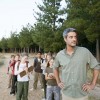 Going on a field trip? Want a spiffy new poster? Looking for a guest speaker? Or do you just need to know more about wildland fire, endangered species, coastal management, or invasive exotics? Many agencies are available to provide information, share resources, support field trips, and contribute to your environmental education programming. This 8-page fact sheet explores federal and state agencies in Florida with major educational resources. Written by Martha C. Monroe and Alison W. Bowers, and published by the UF Department of School of Forest Resources and Conservation, December 2012.
Going on a field trip? Want a spiffy new poster? Looking for a guest speaker? Or do you just need to know more about wildland fire, endangered species, coastal management, or invasive exotics? Many agencies are available to provide information, share resources, support field trips, and contribute to your environmental education programming. This 8-page fact sheet explores federal and state agencies in Florida with major educational resources. Written by Martha C. Monroe and Alison W. Bowers, and published by the UF Department of School of Forest Resources and Conservation, December 2012.
http://edis.ifas.ufl.edu/fr128
Parliamentary Procedure: Previous Question (WC138)
 The motion Previous Question is used to immediately close debate and to prevent the making of all subsidiary motions, except for the motion to Lay on the Table. Ordering the Previous Question does not prevent the making of any privileged or incidental motions, has no effect on the last question considered by the assembly, and is not allowed in committees. This 2-page fact sheet was written by Agricultural Education and Communication, and published by the UF Department of James E. Dyer, January 2013.
The motion Previous Question is used to immediately close debate and to prevent the making of all subsidiary motions, except for the motion to Lay on the Table. Ordering the Previous Question does not prevent the making of any privileged or incidental motions, has no effect on the last question considered by the assembly, and is not allowed in committees. This 2-page fact sheet was written by Agricultural Education and Communication, and published by the UF Department of James E. Dyer, January 2013.
http://edis.ifas.ufl.edu/wc138
Parliamentary Procedure: Lay on the Table (WC137)
 The motion to Lay on the Table is used to temporarily delay action on a pending question while something else of immediate urgency needs consideration, or when another item of business needs to be addressed before consideration of the pending question. This 2-page fact sheet was written by Agricultural Education and Communication, and published by the UF Department of James E. Dyer, January 2013.
The motion to Lay on the Table is used to temporarily delay action on a pending question while something else of immediate urgency needs consideration, or when another item of business needs to be addressed before consideration of the pending question. This 2-page fact sheet was written by Agricultural Education and Communication, and published by the UF Department of James E. Dyer, January 2013.
http://edis.ifas.ufl.edu/wc137
Parliamentary Procedure: Preparing Minutes of a Meeting (WC136)
 An official copy of the minutes of a meeting should be kept in a manner that is accessible to the membership, yet preserves their integrity as a historical record of the organization. This 4-page fact sheet was written by Agricultural Education and Communication, and published by the UF Department of James E. Dyer, January 2013.
An official copy of the minutes of a meeting should be kept in a manner that is accessible to the membership, yet preserves their integrity as a historical record of the organization. This 4-page fact sheet was written by Agricultural Education and Communication, and published by the UF Department of James E. Dyer, January 2013.
http://edis.ifas.ufl.edu/wc136
Capturing Change: Comparing Pretest-Posttest and Retrospective Evaluation Methods (WC135)
 Two models that are commonly used in Extension programming to capture change over a short period of time are the pretest-posttest model and the retrospective pretest (or post-then-pre) model. When deciding which model to use, Extension professionals should keep in mind that each participant has a knowledge base that includes both factual information and perceptions pertaining to factual information. As you read about the strengths and weaknesses of these two design models, consider how each model fits the evaluation situation to select the one that can best measure change in your program. This 4-page fact sheet was written by Agricultural Education and Communication, and published by the UF Department of Jessica L. Gouldthorpe and Glenn D. Israel, January 2013.
Two models that are commonly used in Extension programming to capture change over a short period of time are the pretest-posttest model and the retrospective pretest (or post-then-pre) model. When deciding which model to use, Extension professionals should keep in mind that each participant has a knowledge base that includes both factual information and perceptions pertaining to factual information. As you read about the strengths and weaknesses of these two design models, consider how each model fits the evaluation situation to select the one that can best measure change in your program. This 4-page fact sheet was written by Agricultural Education and Communication, and published by the UF Department of Jessica L. Gouldthorpe and Glenn D. Israel, January 2013.
http://edis.ifas.ufl.edu/wc135
Design and Implementation of Edible Plant Demonstration Gardens: A Case Study of the Putnam County Extension Edible Garden (ENH1205/EP466)
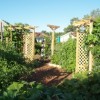 Demonstration gardens are a collection of plants assembled and organized in a manner that allows garden visitors to access and study them. Most gardens are designed with a particular focus and include plants that support the purpose and educational theme of the garden. This case study features an edible plant demonstration garden that was designed and installed in Hastings, Florida, on the Extension office grounds. The UF/IFAS program and the Partnership for Water, Agriculture, and Community Sustainability (FPWACS) designed and implemented the demonstration garden using a step-by-step process that is discussed in this 15-page fact sheet written by Gail Hansen, Joseph Sewards, Rebecca Almeida, and Andrew Dunn, and published by the UF Department of Environmental Horticulture, November 2012.
Demonstration gardens are a collection of plants assembled and organized in a manner that allows garden visitors to access and study them. Most gardens are designed with a particular focus and include plants that support the purpose and educational theme of the garden. This case study features an edible plant demonstration garden that was designed and installed in Hastings, Florida, on the Extension office grounds. The UF/IFAS program and the Partnership for Water, Agriculture, and Community Sustainability (FPWACS) designed and implemented the demonstration garden using a step-by-step process that is discussed in this 15-page fact sheet written by Gail Hansen, Joseph Sewards, Rebecca Almeida, and Andrew Dunn, and published by the UF Department of Environmental Horticulture, November 2012.
http://edis.ifas.ufl.edu/ep466
Finding Grant Opportunities to Support County Extension Programs (WC134)
 This 3-page fact sheet presents information about where to look for grant opportunities, what to look for when reviewing grant opportunities, and how to determine if the opportunity fits your idea. Written by Amy Harder, Alexa Lamm, and Sebastian Galindo, and published by the UF Department of Agricultural Education and Communication, December 2012.
This 3-page fact sheet presents information about where to look for grant opportunities, what to look for when reviewing grant opportunities, and how to determine if the opportunity fits your idea. Written by Amy Harder, Alexa Lamm, and Sebastian Galindo, and published by the UF Department of Agricultural Education and Communication, December 2012.
http://edis.ifas.ufl.edu/wc134